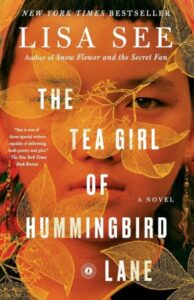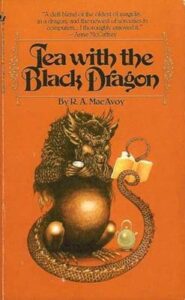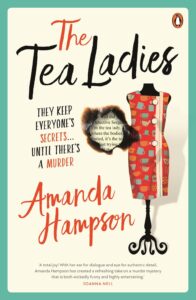Hello my name is Adeline Teoh and I am a book nerd. I belong to three book clubs* and I run one: the (very occasional) Tea Book Club at Ms.Cattea in Sydney.
Now, there are a lot of tea books in the world, but the ones people tend to recommend are non-fiction and reference books. In fiction I’ve noticed that tea novels tend to fall into one of three genres – historical fiction, speculative fiction (sci-fi/fantasy) and cosy mystery – which I find fascinating as a book nerd. Why these three genres in particular?
Historical fiction
There are a lot of turning points in history where tea is a (sometimes hidden) catalyst. As Erika Rappaport writes in her (non-fiction) book A Thirst for Empire: “When I began writing this book I did not foresee the way that tea would uncannily show up as a protagonist in key events, movements and turning points…” She was writing about the British empire, but it’s true of many events in Chinese, Japanese and Dutch history, too.
This gives historical fiction authors a lot of leeway to work a plot into a tea-infused conflict or change, where fictional characters are given a story as they react to upheavals that happened in real life.
Here are a handful I recommend:
- The Tea Rose by Jennifer Donnelly, set in 19th-century London and New York;
- The Teahouse Fire by Ellis Avery, set in Meiji-era Japan;
- The Tea Girl of Hummingbird Lane by Lisa See, set in Maoist China and the modern day; and
- The Last Tea Bowl Thief by Jonelle Patrick, set across Edo-era Japan, World War II and the modern day.
On my to-be-read list is The Tea Chest by Heidi Chiavaroli, Teatime for the Firefly by Shona Patel and The Tea Planter’s Wife by Dinah Jefferies.
Nicole Wilson of Tea For Me Please says Sarah Rose’s For All the Tea in China is historical fiction (Wilson says she has seen accounts about the period regarding Robert Fortune that point to this book being largely fictionalised), but as the publisher classes this book as history, I won’t list it here among the fiction. You can, however, read my review about it.
Speculative fiction
The other, more surprising, place where I find a lot of tea in fiction is in the sci-fi and fantasy genres. It might be that tea intersects with food, medicine and culture in such a way that its use in fantasy helps with world-building, or that its appearance in a sci-fi narrative can offset some of the more technology-driven aspects of a setting.
I think of Star Trek‘s Captain Picard saying “Tea. Earl Grey. Hot” as a neat bit of humanising in a show about a spaceship crew on an intergalactic diplomacy mission. Here’s the captain reaching for something that will help him think about his next move, or give him a little rest from the tribulations of the day.
And of course there’s Arthur Dent’s attempt to obtain a cuppa from the Nutrimatic drinks dispenser in The Hitchhiker’s Guide to the Galaxy, in which he receives something “almost, but not quite, entirely unlike tea”. Perhaps a comment on how we should save the earth because it’s the only planet with tea – a taste that can’t be replicated with a machine that supposedly dispenses everything.
Here are a handful I recommend:
- Tea with the Black Dragon by RA MacAvoy is a 1983 cybercrime classic in which the titular black dragon may or may not be the embodiment of tea;
- The Tea Master and the Detective by Aliette de Bodard is the first novella set in the Universe of Xuya, blending Sherlock Holmes with herbal concoctions (de Bodard is also a well-known tea lover);
- Ancillary Justice by Ann Leckie and the series that follows features a race of people for which tea is incredibly culturally important. Leckie is very clear that this is Camellia sinensis;
- Memory of Water by Emmi Itäranta is about a futuristic Nordic place where water is scarce and the role of tea ceremony practitioners comes under contention;
- A Psalm for the Wild-Built by Becky Chambers is the first of the Monk & Robot series in which a monk sets off in a caravan to bring tea and hospitality to the people and meets a robot – the first contact between human and robot in living memory. It’s utterly charming.
On my to-be-read pile is Spice Road by Maiya Ibrahim, The Splinter in the Sky by Kemi Ashing-Giwa and Can’t Spell Treason Without Tea by Rebecca Thorne.
Cosy mystery
And lastly, there’s something about tea that screams ‘cosy’, so you can imagine that when you set a mystery – or a murder – in a tea shop there’ll be a cuppa or two to provide comfort and soften the edges.
Laura Childs has a whole series called the Tea Shop Mysteries with fanciful book titles like Pekoe Most Poison. I’ve only read the first book, Death by Darjeeling (the mystery genre really isn’t my thing) and I counted 17 teas in it, which is pretty impressive.
NZ author Katherine Hayton also has a short Tea Cozy Mystery series and English writer Alice Castle has Murder at the Tea Shop in her Sarah Vane chronicles.
A shoutout, too, to Amanda Hampson’s The Tea Ladies, which is about 1960s Sydney. It may not be set in a tea shop, but tea ladies were part of the fabric (pardon the pun – it’s set in the rag district) of workplaces at the time, and these ones solve mysteries because they know things and make connections others can’t.
Do you have a tea fiction recommendation? Let me know!
*For speculative fiction by Australian and NZ authors; for diverse Australian authors; and books in translation.


